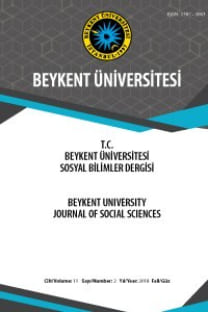TÜRKİYE’DE ENERJİ TÜKETİMİNİN EKONOMİK BÜYÜME ÜZERİNDEKİ ETKİSİ
Bu çalışmada, Türkiye’de ekonomik büyüme ile enerji tüketimi ilişkisi, 1970–2003
dönemi için incelenmiştir. Ekonomik büyüme ve enerji tüketimi serileri, farklı
derecelerden durağan (I(0) ve I(1)) oldukları için, aralarındaki ilişki, Sınır Testi
yaklaşımı ile araştırılmıştır. Bu yaklaşıma göre, seriler arasında eşbütünleşme ilişkisi
tespit edilmiş; kısa dönemde değişkenler arasında pozitif bir ilişki ortaya çıkarken, uzun
dönemde istatistiksel olarak anlamlı bir ilişki bulunamamıştır.
Anahtar Kelimeler:
Ekonomik büyüme, enerji tüketimi, eşbütünleşme, sınır testi, ARDL modeli
Özet: Bu çalısmada, Türkiye’de ekonomik büyüme ile enerji tüketimi iliskisi, 1970–2003 dönemi için incelenmistir. Ekonomik büyüme ve enerji tüketimi serileri, farklı derecelerden duragan (I(0) ve I(1)) oldukları için, aralarındaki iliski, Sınır Testi yaklasımı ile arastırılmıstır. Bu yaklasıma göre, seriler arasında esbütünlesme iliskisi tespit edilmis; kısa dönemde degiskenler arasında pozitif bir iliski ortaya çıkarken, uzun dönemde istatistiksel olarak anlamlı bir iliski bulunamamıstır.
___
Akarca, A.T. T.V. Long (1980) “On the relationship between energy and GNP: a reexamination”, Journal of Energy and Development, Vol. 5, pp. 326-331Al-İ., Mahmoud A., (2006). “Energy-GPD Relationship Revisited: An Example from GCC Countries Using Panel Countries”, Energy Policy, Article in Pres
Altinay, G., Karagol, E., (2004). “Structural Break, Unit Root, and the Causality between Energy Consumption and GDP in Turkey”, Energy Economics, 26, pp. 985-994.
Asafu-Adjaye, J.,(2000). “The relationship between energy consumption, energy prices and economic growth: time series evidence from Asian developing countries.” Energy Economics, Vol. 22, No. , pp. 615–625.
Dickey, D., W. Fuller, (1979). “Distribution of the estimators for autoregressive time series with a unit root.” Journal of American Statistical Association, Vol. 74, No.pp. 427-431.
Engel, R.F., Granger, C.W.J. (1987).”Co-integration and Error Correction Representation, Estimation and Testing” Econometrica, Vol. 55, No.2, pp. 251-276.
Erol, U., Yu, E. S. H., (1987). “On the Relationship Between Energy and Income for Industrialized Countries”, Journal of Energy and Employment, pp.113-122.
Gujarati, D.N., (1999) “Temel Ekonometri”, (Çev. Ü. Şenesen & G.G. Şenesen). İstanbul, Literatür Yayınları.
Johansen, S. (1988). “Statistical Analysis of Co-integration Vectors”, Journal of Economic Dynamics and Control Vol. 12, No. 2/3, pp. 231-254. 10. Johansen, S., Juselius, K. (1990) “Maximum Likelihood Estimation and Inference on Co-integration-With Applications to the Demand For Money”, Oxford Bulletin of Economics and Statistics, Vol. 52, No. 2, pp.169-210.
IEA OECD Statistics Data Base (2004)
Kraft, J. A. Kraft, (1978) “On the relationship between energy and GNP”, Journal of Energy and Development, Vol.3, No. , pp. 401-403.
Kutlar, A., (2000). Ekonometrik Zaman Serileri. Ankara: Gazi Kitapevi
Lee, C. C., (2005). “Energy Consumption and GDP in Developing
Countries: A Co integrated Panel Analysis”, 27, pp. 415-427
Masih, A. M. M., Masih R., (1997). “On the Temporal Causal Relationship Between Energy Consumption, Real Income and Prices: Some Evidence From Asian-Energy Dependent NICs Based on A Multivariate Co- integration/Vector Error Correction Approach”, Journal of Policy Modelling, 19, pp. 417-440
Narayan S., Narayan P. K. (2004). “Determinants of Demand of Fiji’s Exports: An Empirical Investigation” The Developing Economics XVII-1 95-112
Narayan, P.K., Smyth, R. (2006). “What determines migration flows from low-income to high-income countries? An empirical investigation of Fiji- US Migration 1972–2001.” Contemporary Economic Policy, vol. 24, No.2, pp. 332–342.
Pesaran, M. H. Shin, Y., Smith, R.J., (2001) “Bounds Testing Approaches to the Analysis of Level Relationships”, Journal of Applied Econometrics, 16, pp.289-326
Phillips, P.C.B., Perron, P., (1988). “Testing for a unit root in time series regression.” Biomètrika75 (2) 336-346.
Rufael, Y. W., (2005). “Energy Demand and Economic Growth:
The African Experience”, Journal of Policy Modeling, 27, pp. 891-903
Stern, D.I., (1993). “Energy and Economic Growth in the USA:A Multivariate Approach”, Energy Economics, 15, pp.137-150.
Stern, D.I., (2000). “Multivariate co-integration analysis of the role of energy in the US macro economy.” Energy Economics, Vol. 22, pp. 267– 283.
Stern, D.I., Cleveland, J. C., (2004). “Energy and Economic Growth”, Rensselaer Working Papers in Economics, pp. 1-42.
Soytaş,U., Sarı,R., Özdemir,Ö., (2001). “Energy Consumption and GNP Relation in Turkey: A Co-integration and Vector Error Correction Analysis”, Global Business and Technology Association, p.838-844
Soytaş, U., Sarı, R., (2003). “Energy Consumption and GDP: A Causality relationship in G–7 Countries and Emerging Markets”, Energy Economics, 25, pp.33–37
TÜİK (Türkiye İstatistik Kurumu) İstatistiksel Göstergeler 2004.
- ISSN: 1307-5063
- Yayın Aralığı: Yılda 2 Sayı
- Başlangıç: 2007
- Yayıncı: Beykent Üniversitesi
Sayıdaki Diğer Makaleler
TÜRKİYE’DEKİ PARA KRİZLERİNİN REEL DEĞİŞKENLERLE SİNYAL YAKLAŞIMIYLA ÖNGÖRÜLEBİLİRLİĞİ
ATATÜRKÇÜ DÜŞÜNCE SİSTEMİ VE AVRUPA BİRLİĞİ DEĞERLERİ
KÖKTENCİ SANATTA DEVRİMSEL GELGİT: KAVRAM-İMGE DİYALEKTİĞİ
DÜŞÜNCE, İNSAN DİLİ VE SANAT DİLİ
Cengiz ASİLTURK, Cengiz ASİLTÜRK
TÜRKİYE’DE ENERJİ TÜKETİMİNİN EKONOMİK BÜYÜME ÜZERİNDEKİ ETKİSİ
Erman ERBAYKAL, Erman ERBAYKAL
VERGİ POLİTİKALARI VE İKTİSADİ GELİŞME İLİŞKİSİ:TÜRKİYE ÜZERİNE ZAMAN SERİLERİ ANALİZİ (1987-2002)
FAKİR BAYKURT’UN HİKÂYELERİNDE TEMA
ENERJİ KAYNAKLARINDAN PETROL VE DOĞALGAZDAKİ TEKEL OLUŞUMLARI
